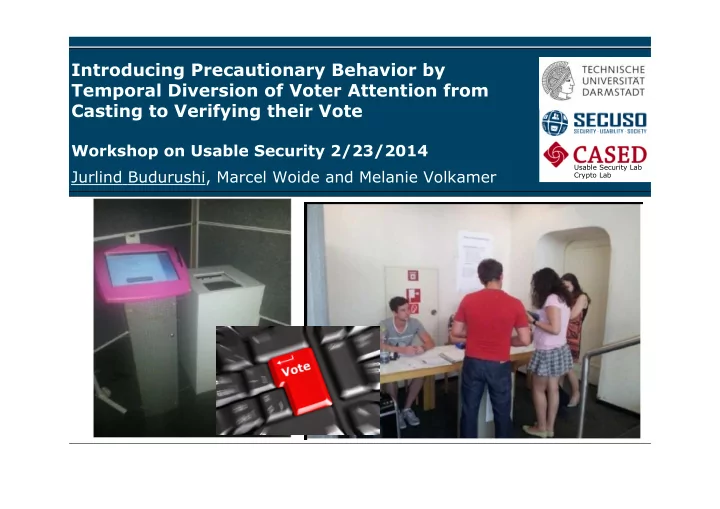

Introducing Precautionary Behavior by Temporal Diversion of Voter Attention from Casting to Verifying their Vote Workshop on Usable Security 2/23/2014 Usable Security Lab Jurlind Budurushi, Marcel Woide and Melanie Volkamer Crypto Lab
Current e-voting systems Manually Paper Audit Trails (PATs) Automatic | Jurlind Budurushi | USEC’14 | 2/23/2014 2
Security in theory and practice § Election frauds can be detected with PATs => Assumption: Voters verify § But, voters are not likely to verify PAT according to previous user studies => Challenge: Motivate voters to verify PAT | Jurlind Budurushi | USEC’14 | 2/23/2014 3
Goal: Develope an adequate stimulus | Jurlind Budurushi | USEC’14 | 2/23/2014 4
Focus: Manually depositing PAT | Jurlind Budurushi | USEC’14 | 2/23/2014 5
Design restrictions PATs as protection against malicious voting systems „Thank you for voting!“ | Jurlind Budurushi | USEC’14 | 2/23/2014 6
Stimulus: Failed example 1 | Jurlind Budurushi | USEC’14 | 2/23/2014 7
Stimulus: Failed example 2 | Jurlind Budurushi | USEC’14 | 2/23/2014 8
Stimulus Position and timing Pre-printed instructions | Jurlind Budurushi | USEC’14 | 2/23/2014 9
Pre-printed instructions | Jurlind Budurushi | USEC’14 | 2/23/2014 10
Preliminaries for user study § Hide goal of the study to not bias participants § Manipulate PAT to identify actual verification behavior § No legally binding elections because of manipulation § No election simulation to not violate vote secrecy § No election with voting agenda because PAT should have personal relevance | Jurlind Budurushi | USEC’14 | 2/23/2014 11
Cover story § Communicated study goal: § Memory test § Identify information that people can better remember § Candidate selection ~ Answer questions on PC § Auditing ~ Verify printed answers on the PAT § Depositing ~ Handover PAT to the experimenter | Jurlind Budurushi | USEC’14 | 2/23/2014 12
Type of „PAT“ manipulation § Not easy to find => Question 7 § As easy to notice, as changing candidate‘s name => 1845 printed as birthday (1910, 1911, 1912) | Jurlind Budurushi | USEC’14 | 2/23/2014 13
Group differences § Reading guidelines § Control group: Pre-printed instructions § Study group: no instructions § Verifying printout (paper audit trail) § Control group confronted with blank printout § Study group confronted with the stimulus | Jurlind Budurushi | USEC’14 | 2/23/2014 14
Participants § Recruiting: E-Mail and personal contact § Sample § 65 participants (34F, 31M), between 19-59 years old § 40 students, 25 employees (academics, civil servants, freelancers, administrative technical staff members, caretakers, and event managers) § Compensation: CPs for psych. students, rest 20 € Amazon voucher | Jurlind Budurushi | USEC’14 | 2/23/2014 15
Results Variable Control Study χ 2 -Test MW-Test group group Detected 5 out of 26 30 out of 39 Diff. highly - (19%) (77%) significant Awareness - - - Significant (Likert scale) difference Compensation 8 psych. 13 psych. No significant - students students difference within group and between both groups False positive 21 out of 26 9 out of 39 - - (self-reports) | Jurlind Budurushi | USEC’14 | 2/23/2014 16
Conclusion The developed stimulus is a promising solution towards motivating voters to verify PATs THANK YOU FOR YOUR ATTENTION! | Jurlind Budurushi | USEC’14 | 2/23/2014 17
Backup - Slides | Jurlind Budurushi | USEC’14 | 2/23/2014 18
References § [Cohen, 2005] S. B. Cohen, “Auditing Technology for Electronic Voting Machines”, master thesis, MIT, Media Lab, 2005. § [Herrnson et al., 2005] P. S. Herrnson, R. G. Niemi, M. J. Hanmer, P. L. Francia, B. B. Bederson, F. Conrad, and M. Traugott, “The promise and pitfalls of electronic voting: results from a usability field test”, 2005. § [Selker et al., 2006] T. Selker and A. Pandolfo, “A methodology for testing voting systems”, Journal of Usability Studies, vol. 2, no. 1, pp. 7–21, 2006. § [van Hoff et al., 2007] J. J. van Hoff, J. F. Gosselt, and M. D. T. de Jong, “The reliability and usability of the Needap voting machine: A pilot study”, 2007 University of Twente | Jurlind Budurushi | USEC’14 | 2/23/2014 19
Recommend
More recommend